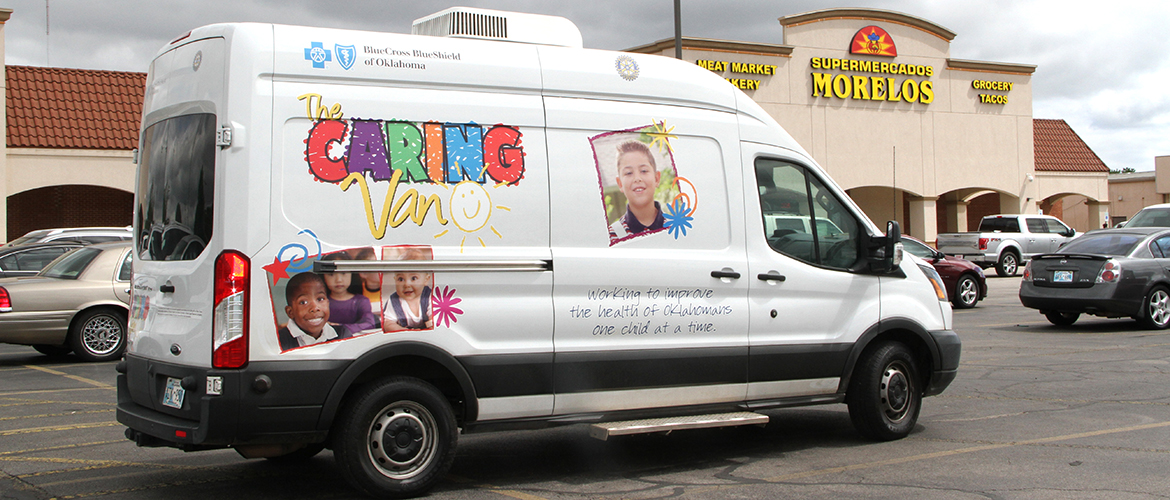Blue Cross and Blue Shield of Oklahoma and the Oklahoma Caring Foundation recently mobilized Caring Vans to support coronavirus testing efforts in underserved areas across the state.
With help from the Caring Vans, Gov. Kevin Stitt surpassed his May goal of testing 2% of the population — 90,000 residents — as Oklahoma eased restrictions established to slow the spread of the virus. Oklahoma performed nearly 113,300 COVID-19 tests before the end of May.
“Tracing (virus spread) and testing are absolutely essential to reopening our state,” Stitt said at a recent news conference.
Joseph R. Cunningham, M.D., president of Blue Cross and Blue Shield of Oklahoma, said the vans, which had been used at childhood immunization clinics before the coronavirus outbreak idled them, would be vital in reaching residents who don’t have access to one of the state’s 80 testing sites. BCBSOK provides an in-kind donation to support the Caring Foundation and their Caring Van program.
“Blue Cross and Blue Shield of Oklahoma knew we needed to do something in this effort,” he said. “We also knew it’s critical for us to perform more tests to have a better handle on this extremely contagious infection.”
Five Caring Vans were used to test more than 880 people in underserved parts of Oklahoma.
Coronavirus exposes health disparities
Cunningham’s concern underscores how many Oklahomans face critical illness if infected by the coronavirus. Almost every county across the state has reported at least one confirmed COVID-19 case.
Although Oklahoma hasn’t been hit as hard as some other states by the outbreak, longstanding disparities in health conditions and social and economic experiences are magnifying the toll the COVID-19 pandemic is taking throughout the country. The coronavirus’ effect on Oklahoma could be especially devastating because it is one of the unhealthiest states in the country.
Among adult Oklahomans, 27% have at least one chronic health condition that increase risk of severe COVID-19 disease — cardiovascular disease, diabetes and asthma.
Nearly 70% of those who died from COVID-19 in the state had at least one chronic condition, according to state health officials.
Also, Oklahoma has the nation’s second highest uninsured rate at 16%. So, many residents may not get the care need to prevent or control underlying conditions that put them at higher risk of severe cases of COVID-19 if they’re infected.
“We have a problem with health disparities all over America, and that disparity is existent in Oklahoma City,” State Sen. George Young said at the news conference with Stitt.
Young’s district includes underserved communities of Oklahoma City where the Caring Vans will be deployed for testing. “I think we can make a dent in those disparities, but we’ve got to keep pushing,” he said. “Blue Cross and Blue Shield is helping answer the call.”
Rural areas at high risk
Almost a third of Oklahomans — about 1.3 million — live in rural areas, where limited health care access is among the reasons they may be at higher risk of dying from COVID-19.
Mangum, a town with a population of about 2,765 in the lower southwest corner of the state, became a coronavirus hotspot earlier this year. More than 30 people tested positive for COVID-19 and four died after a March visit to a Mangum nursing home by a traveling evangelist, who became Oklahoma’s first COVID-19 death.
Researchers at Oklahoma State University Center for Rural Health wrote that the Mangum outbreak shows how a combination of factors — obesity, diabetes, age and heath care access — can increase a small community’s vulnerability to the coronavirus, even though larger cities such as Oklahoma City and Tulsa report higher numbers of cases and deaths.
Greer County — where Mangum is the county seat — has among the highest rates of coronavirus cases and deaths of any non-metro area in the country, according to the Kaiser Family Foundation.
“It is imperative that rural residents understand the elevated risks associated with COVID-19 in their communities,” the OSU report states. “As Greer and other counties across the nation have learned, one case can multiply exponentially, amplifying the effects of poor health status in rural communities and overwhelming the fragile infrastructure of rural health care.”
Serving communities
BCBSOK has a longstanding commitment to improving access the health care and coverage across the state. Its Mobile Assistance Center (MAC) team travels the state to help people enroll in coverage and use their benefits. BCBSOK also invests in programs supporting the physician workforce in rural communities, and the Caring Van program delivered preventive health services to nearly 26,000 Oklahomans last year.
“As a physician, I took an oath to take care of all people, regardless of their race, regardless of income, regardless of where they live,” Cunningham said of the partnership with the state health department. “They had (coronavirus) tests. We had the mobile capability, and now we’re able to help communities across our state.”

